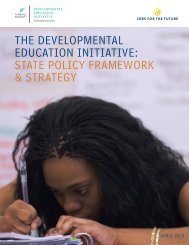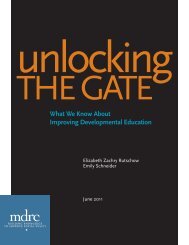Preparing High School Students for College - ERIC - U.S. ...
Preparing High School Students for College - ERIC - U.S. ...
Preparing High School Students for College - ERIC - U.S. ...
- No tags were found...
You also want an ePaper? Increase the reach of your titles
YUMPU automatically turns print PDFs into web optimized ePapers that Google loves.
Implications <strong>for</strong> <strong>College</strong> Readiness Partnership ProgramsSelecting Interventions That Show PromiseSome of the studies referenced in the first chapter of this report suggest that certainprogram elements such as mentoring by adults or peers, and assisting students with thecollege application process may be more likely to result in positive outcomes (Gándara,2001). In addition, program descriptions based on our site visits, included in Appendix A,outline approaches to college readiness partnerships that have been field-tested in Texashigh schools and colleges. Choosing interventions that show the greatest promise in a givencontext can enhance the chances of success.Matching <strong>Students</strong> and Interventions<strong>College</strong> readiness programs are relatively scarce. Further, many programs, especiallythose that are more intensive, can only serve limited numbers of students. Institutions maywant to match college-going students who are academically underprepared with moreintensive programs and direct those students who primarily need assistance with collegeknowledge to less intensive programs. The early assessment of students’ college readiness, apractice that we observed in a number of school districts, is a useful strategy <strong>for</strong> identifyingstudents’ needs and facilitating better matches between students and programmatic supports.Sequencing InterventionsAs we looked at programs offered by high schools and colleges, we often sawpromising programs that were not explicitly linked with one another. For example, in severalcases, a college-sponsored summer program <strong>for</strong> high school students was not aligned withactivities planned <strong>for</strong> students during the following school year. Linking secondary andpostsecondary college readiness programs may allow each type of institution to leverage theservices of the other, creating an opportunity to maximize the potential gains <strong>for</strong> students.Planning <strong>for</strong> Expected ChallengesDuring our site visits we learned about common challenges faced during programimplementation. Institutions struggled particularly with student recruitment, retention, andprogram sustainability. These challenges are worth considering — and planning <strong>for</strong> — earlyon in the development of college readiness partnership programs.financial need, or other criteria, it creates a circumstance under which students close to but on either sideof the cut point that determines acceptance into the program are highly comparable).30





